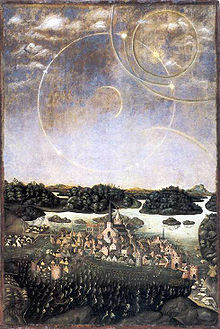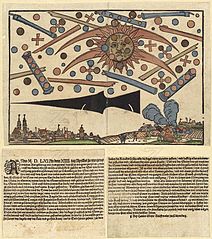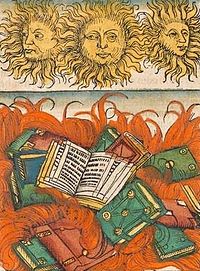- Sun dog
-
For other uses, see Sun dog (disambiguation).
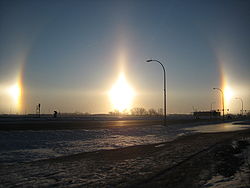 Very bright sundogs in Fargo, North Dakota. Note the halo arcs passing through each sundog.
Very bright sundogs in Fargo, North Dakota. Note the halo arcs passing through each sundog.
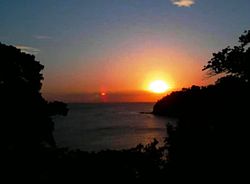 A crimson sundog in Camaya Coast, Mariveles, Bataan at the left side of the setting sun. Note that the other sundog (at the right side) is obstructed from view.
A crimson sundog in Camaya Coast, Mariveles, Bataan at the left side of the setting sun. Note that the other sundog (at the right side) is obstructed from view.
A sun dog or sundog, scientific name parhelion (plural parhelia) from Greek παρήλιον (parēlion), meaning "beside the sun"; from παρά (para), meaning "beside", and ἥλιος (helios), meaning "sun", also called a mock sun[1] or a phantom sun[2], is an atmospheric phenomenon that creates bright spots of light in the sky, often on a luminous ring or halo on either side of the sun.[3]
Sundogs may appear as a colored patch of light to the left or right of the sun, 22° distant and at the same distance above the horizon as the sun, and in ice halos. They can be seen anywhere in the world during any season, but they are not always obvious or bright. Sundogs are best seen and are most conspicuous when the sun is low.
Contents
Formation and characteristics
Sundogs are made commonly of plate-shaped hexagonal ice crystals in high and cold cirrus clouds or, during very cold weather, by ice crystals called diamond dust drifting in the air at low levels. These crystals act as prisms, bending the light rays passing through them with a minimum deflection of 22°. If the crystals are randomly oriented, a complete ring around the sun is seen — a halo. But often, as the crystals sink through the air they become vertically aligned, so sunlight is refracted horizontally — in this case, sundogs are seen.
As the sun rises higher, the rays passing through the crystals are increasingly skewed from the horizontal plane. Their angle of deviation increases and the sundogs move further from the sun.[4] However, they always stay at the same elevation as the sun.
Sundogs are red-colored at the side nearest the sun. Farther out the colors grade through oranges to blue. However, the colors overlap considerably and so are muted, never pure or saturated. The colors of the sundog finally merge into the white of the parhelic circle (if the latter is visible).
It is theoretically possible to predict the forms of sundogs as would be seen on other planets and moons. Mars might have sundogs formed by both water-ice and CO2-ice. On the giant gas planets — Jupiter, Saturn, Uranus and Neptune — other crystals form the clouds of ammonia, methane, and other substances that can produce halos with four or more sundogs.[5]
History
 A parhelion at the South Pole. The image also shows a 22° halo (circle), a parhelic circle (the curved line extending between and beyond the parhelion and the sun), an upper tangent arc and a Parry arc.
A parhelion at the South Pole. The image also shows a 22° halo (circle), a parhelic circle (the curved line extending between and beyond the parhelion and the sun), an upper tangent arc and a Parry arc.
Greece
Aristotle (Meteorology III.2, 372a14) notes that "two mock suns rose with the sun and followed it all through the day until sunset." He says that "mock suns" are always to the side, never above or below, most commonly at sunrise or sunset, more rarely in the middle of the day.
The poet Aratus (Phaenomena 880–891) mentions parhelia as part of his catalogue of Weather Signs; for him, they can indicate rain, wind, or an approaching storm.
Rome
A passage in Cicero's On the Republic (54–51 BC) is one of many by Greek and Roman authors who refer to sun dogs and similar phenomena:
Be it so, said Tubero; and since you invite me to discussion, and present the opportunity, let us first examine, before any one else arrives, what can be the nature of the parhelion, or double sun, which was mentioned in the senate. Those that affirm they witnessed this prodigy are neither few nor unworthy of credit, so that there is more reason for investigation than incredulity.[6]Seneca speaks of them diffusely in the first book of his Naturales Quaestiones.[7]
The 2nd century Roman writer and philosopher Apuleius in his Apologia XV says "What is the cause of the prismatic colours of the rainbow, or of the appearance in heaven of two rival images of the sun, with sundry other phenomena treated in a monumental volume by Archimedes of Syracuse."
Wars of the Roses
The prelude to the Battle of Mortimer's Cross in Herefordshire, England in 1461 is supposed to have involved the appearance of a complete parhelion with three "suns". The Yorkist commander, later Edward IV, convinced his initially frightened troops that it represented the Holy Trinity and Edward's troops won a decisive victory.
Jakob Hutter
Possibly the earliest clear description of a sundog is by Jacob Hutter, who wrote in his Brotherly Faithfulness: Epistles from a Time of Persecution:
My beloved children, I want to tell you that on the day after the departure of our brothers Kuntz and Michel, on a Friday, we saw three suns in the sky for a good long time, about an hour, as well as two rainbows. These had their backs turned toward each other, almost touching in the middle, and their ends pointed away from each other. And this I, Jakob, saw with my own eyes, and many brothers and sisters saw it with me. After a while the two suns and rainbows disappeared, and only the one sun remained. Even though the other two suns were not as bright as the one, they were clearly visible. I feel this was no small miracle…[8]The observation most likely occurred in Auspitz (Hustopeče), Moravia in very late October or very early November of 1533. The original was written in German and is from a letter originally sent in November 1533 from Auspitz in Moravia to the Adige Valley in Tyrol. The Kuntz Maurer and Michel Schuster mentioned in the letter left Hutter on the Thursday after the feast day of Simon and Jude, which is October 28.[9]
Vädersolstavlan
The so-called "Sun Dog Painting" (Vädersolstavlan) depicting Stockholm in 1535 and the celestial phenomenon at the time interpreted as an ominous presage
While mostly known and often quoted for being the oldest colour depiction of the city of Stockholm, Vädersolstavlan (Swedish; "The Sundog Painting", literally "The Weather Sun Painting") is arguably also one of the oldest known depictions of a sun dog. For two hours in the morning of April 20, 1535, the skies over the city were filled with white circles and arcs crossing the sky, while additional suns appeared around the sun. The phenomenon quickly resulted in rumours of an omen of God's forthcoming revenge on King Gustav Vasa (1496–1560) for having introduced Protestantism during the 1520s and for being heavy-handed with his enemies allied with the Danish king.
Hoping to end speculations, the Chancellor and Lutheran scholar Olaus Petri (1493–1552) ordered a painting to be produced documenting the event. When confronted with the painting, the king, however, interpreted it as a conspiracy - the real sun of course being himself threatened by competing fake suns, one being Olaus Petri and the other the clergyman and scholar Laurentius Andreae (1470–1552), both thus accused of treachery, but eventually escaping capital punishment. The original painting is lost, but a copy from the 1630s survives and still can be seen in the church Storkyrkan in central Stockholm.[10]
Nuremberg, Germany in 1561
Sun dogs might explain a remarkable phenomenon observed in Germany: on April 4, 1561, the skies over Nuremberg, Germany were filled with a multitude of celestial objects that were observed by many people in the city. The phenomenon was described in a News notice (an early form of newspaper) published in Nuremberg on April 14, 1561, along with a woodcut by Hans Glaser, depicted to the right.[11]
Influence on Descartes in 1629
A set of powerful parhelia in Rome in the Summer of 1629 caused René Descartes to interrupt his metaphysical studies and led to his work of natural philosophy called "The World".[12]
Other citations
Fiction
- Shakespeare appears to mention the phenomenon in his Henry VI, Part 3, written in about 1590, when he has Edward say, "Dazzle mine eyes, or do I see three suns?"
- The poem Die Nebensonnen ("The Parhelia"), by Wilhelm Müller from his 1823–4 cycle Winterreise, was set to music by Franz Schubert. It begins: "Drei Sonnen sah ich am Himmel stehn…" ("Three Suns I saw in the sky").
- Jack London wrote a short story in 1905 called The Sun-Dog Trail.[13]
- In the 1949 novel Mrs. Mike by Benedict and Nancy Mars Freedman, Sgt. Mike Flannigan, a Canadian Mountie, explains sun dogs when they are seen by his young Bostonian wife for the first time. Claiming to have observed as many as sixteen of them together in the sky at a single time, he says the Indians believe they are "evil stars trying to kill the sun," but that they are actually caused by atmospheric conditions, and that when they appear "ten to one there's a blizzard by the morning."
- A reference to 'parhelia' occurs in the Introduction to Vladimir Nabokov's 1962 novel Pale Fire:
The short (166) Canto One, with all those amusing birds and parhelia, occupies thirteen cards.[14]
...and that rare phenomenon
The iridule—when beautiful and strange,
In a bright sky above a mountain range
One opal cloudlet in an oval form
Reflects the rainbow of a thunderstorm…- In the fifth novel of the Aubrey–Maturin series, Desolation Island, 1978, Patrick O'Brian writes:
A visit to the cabin showed him the glass lower still: sickeningly low. And back on the poop he saw that he was by no means the only one to have noticed the mounting sea — an oddly disturbed sea, as if moved by some not very distant force; white water too, and a strange green colour in the curl of the waves and in the water slipping by. He glanced north-west, and there the sun, though shining still, had a halo, with sun-dogs on either side. Ahead, the aurora had gained in strength: streamers of an unearthly splendour."[15]- In her popular historical novel The Sunne in Splendour, 1982, about Richard III of England, Sharon Kay Penman writes:
Hastings laughed, too, and shook his head. "Men do make their luck, Lady Margaret, and never have I seen that better proven than at Mortimer's Cross. For ere the battle, there appeared a most fearsome and strange sight in the sky." He paused. "Three suns did we see over us, shining full clear."
In a footnote it is clarified: "Phenomenon known as a parhelion, generally caused by the formation of ice crystals in the upper air." Two pages later, again mentioning the English king Edward IV, she adds: "Many, she saw, flaunted streaming sun emblems to denote her son's triumph under the triple suns at Mortimer's Cross."[16]
- Sundog is the title of a 1984 novel by Jim Harrison.
- The horror fiction writer Stephen King included a novella called The Sun Dog in his 1990 collection Four Past Midnight.
- Jane Gardam at the end of her 2006 novel Old Filth has the main character, Edward Feathers, see a parhelion from the window of a plane at sunrise on New Year's Day:
Later he looked down upon a fat carpet of clouds and saw something he had never seen in his life before. Two suns stood side by side in the sky. A parhelion. A formidable and ancient omen of something or other, he forgot what.[17]Fine arts & film
- One of Robert Rauschenberg's early experiments in 1962 employing the silk-screen process to reuse previously published images in Combine Paintings is titled Sun Dog.
- Ingmar Bergman's film The Passion of Anna opens with a scene showing the protagonist stopping his work to observe three suns in the sky.
- Sun dogs appear in the film The Deer Hunter. At the beginning of the film, as the men are leaving work, they see the phenomenon. Robert De Niro's character describes it as an 'old Indian thing' and "A blessing on the hunter sent by the great wolf to his children".
Popular culture
- "The Dark Side of the Sun", an early science-fiction novel by popular comic fantasy author Terry Pratchett, features a race of telepathic space-travelling beings known as "sundogs", described as vast "fat lozenges" glowing in various colours as adults. As pups they are cone-shaped and furred.
- The minor league hockey team, the Arizona Sundogs, is named after this phenomenon. Their logo features the letter "S" surrounding twin suns.
Popular music
- Sun dogs are referenced in Rush's 1989 song "Chain Lightning" on the album Presto. Neil Peart (lyricist) has been quoted as saying:
"I'm a weather fanatic...I watch the weather...and one night I was watching it and there are two incidents in that song that are synchronicity to one weather report where the weatherman showed a picture of sun dogs...they're a really beautiful natural phenomenon and I love the name, too. Sun dogs just has a great sound to it."[18]
- The band Of Montreal used the image in the lyrics to "The Past Is a Grotesque Animal" on the 2007 album Hissing Fauna, Are You the Destroyer?[19]:
I've played the unraveler, the parhelion
But even Apocalypse is fleeting
There's no death, no ugly world- The British neofolk band Death in June released an EP called "Sun dogs" in 1994.
- Athens, Georgia based jam band Perpetual Groove have back to back songs titled "Perihelion" and "Sun Dog" on their 2003 release Sweet Oblivious Antidote. They are instrumental tracks.
- Sun dogs are mentioned in Paul Simon's 1990 song "The Cool, Cool River" on the album The Rhythm of the Saints.
- Turkish-Austrian electronic music artist Murat Ses dedicated his eighth solo album "Beside the Sun" (2010) to this particular phenomenon.
See also
- 120° parhelion
- Anthelion
- Atmospheric optics
- Circumhorizontal arc
- Corona
- False sunrise
- False sunset
- Infralateral arc
- Liljequist parhelion
- Moon dog
- Moon ring
- The Miracle of the Sun
References
- ^ The American Heritage Dictionary of the English Language http://education.yahoo.com/reference/dictionary/entry/mock%20sun
- ^ http://www.fyoq.com/2011/01/11/phantom-sun-3-suns-over-china-spotted/
- ^ The American Heritage Dictionary of the English Language, 2004
- ^ Cowley, L. "Effect of solar altitude". Atmospheric Optics. http://www.atoptics.co.uk/halo/dogalt.htm. Retrieved 2007-4-15.
- ^ Cowley, L. "Other Worlds". Atmospheric Optics. http://www.atoptics.co.uk/halo/oworld.htm. Retrieved 2007-4-15.
- ^ Cicero; CD Yonge (trans.) (1877). "On the Commonwealth, Book 1". Project Gutenberg. pp. (260), 367, (369). http://www.gutenberg.org/files/14988/14988-h/14988-h.htm#FNA-296.
- ^ Seneca, Ricerche sulla Natura, P. Parroni editor, Mondadori, 2010
- ^ Jakob Hutter (1979). Brotherly Faithfulness: Epistles from a Time of Persecution. Rifton, NY: Plough Publishing. pp. 20–1. ISBN 0-87486-191-8.
- ^ Schaaf, Fred (November, December 1997), Sky & Telescope, p. 94
- ^ Pererik Åberg (2003-07-10). "Vädersolstavlan". Stockholm: Sveriges Television. http://svt.se/svt/jsp/Crosslink.jsp?d=11190&a=99963. Retrieved 2007-01-28.
- ^ Link to Zurich Library digital archive (2 scanned pages) [1]
- ^ René Descartes - Metaphysical turn, Stanford Encyclopaedia of Philosophy
- ^ Williams, James, Jack London's Works by Date of Composition, Sonoma, http://london.sonoma.edu/Essays/comp_date.html
- ^ Vladimir Nabokov (1962). Pale Fire. NY: G. P. Putnam's Sons. p. 315.
- ^ Patrick O'Brian (1978). "9". Desolation Island. NY: Norton. p. 123. ISBN 0-393-30813-8.
- ^ Sharon Kay Penman (1982). "4". The Sunne in Splendour. NY: Ballantine. p. 60. ISBN 0-345-36313-2.
- ^ Jane Gardam (2006). Old Filth (novel). NY: Europa Editions. p. 286. ISBN 1-933372-13-3.
- ^ Neil Peart (1989). Rush Profiled! - Presto, promotional interview CD. Atlantic Records.
- ^ "Of Montreal - The Past Is A Grotesque Animal". SongMeanings.net. 2006-09-09. http://www.songmeanings.net/lyric.php?lid=3530822107858624057. Retrieved 2007-02-16. (The page uses this Wikipedia article as a reference to sort out the 'obscure references' of Kevin Barnes.)
External links
- Sundogs - Parhelia, Explanations and Images
- Optical Phenomena - Photos of sun dogs
- Starry Night Photography - Sun Dog, Sun Halo, Moon Halo - Some photos and some text
- Photo slideshow
- Sun dogs, 4 Suns in the Sky Together
- Images by Crayford Manor House Astronomical Society
- 4 point Sun dog with complete 360 degree ring in Shubarkurduk, Kazachstan
- Rare sun halo appears on Monday, November 1st, 2010
- SDO Sundog Mystery - A phenomenon that occurred during the launch of the Solar Dynamics Observatory
- "Astronomy Picture of the Day: Jumping Sundog video and explanation". NASA. November 8, 2011. http://apod.nasa.gov/apod/ap111108.html. Retrieved Novmber 10,2011.
Categories:- Atmospheric optical phenomena
Wikimedia Foundation. 2010.


